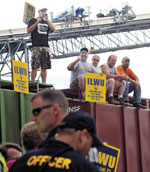
Showdown on West Coast Docks: The Battle of Longview
(November 2011).
click on photo for article
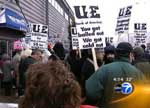
Chicago Plant Occupation Electrifies Labor
(December 2008).
click on photo for article
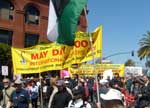
May Day Strike Against the War Shuts Down
U.S. West Coast Ports
(May 2008)
click on photo for article

August 2017
Capitalism Is Wrecking Mass Transit
NYC Transit
Summer of Hell?
What about Winter, Spring and Fall?
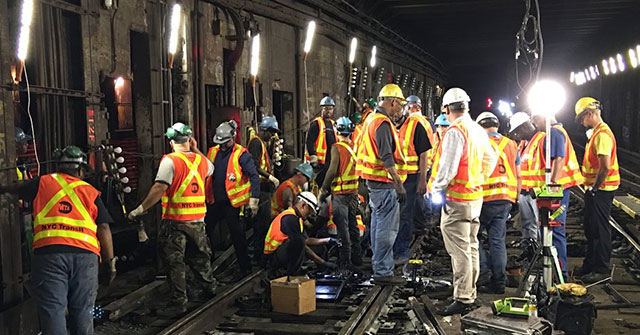
Transit workers repairing 125th Street Station the day after June 27 A train derailment.
(Photo: Transport Workers Union Local 100)
It would be a “summer of hell” for commuters, declared New York Democratic governor Andrew Cuomo. His remark was made in May when it was announced that a major section of interlocking tracks at Penn Station would be out of service for much-needed repairs in July and August. The closures follow a string of preventable train derailments that have left Amtrak, the Metropolitan Transportation Authority (MTA), the New York-New Jersey Port Authority and governors Andrew Cuomo and Chris Christie on the hook for crumbling transit infrastructure, some of which is older than the Bolshevik Revolution, and service that continues to leave straphangers fuming. In response, the capitalist politicians feud and MTA bigwigs put forward an “action plan” featuring their intention to eliminate seats so they can cram more passengers into already overcrowded subway cars! And, of course, more fare hikes.
The first derailment came in late March, when an Amtrak Acela Express train (the high-priced high-speed trains that connect Wall Street moguls and their Washington lackeys) was leaving Pennsylvania Station in the a.m., clipping an NJ Transit train and causing 29 trains to be canceled for the evening’s rush hour. Less than two weeks later, on April 3, an NJ Transit train derailed on the same interlocking section of tracks at Penn Station. On June 27, a southbound A train in Harlem derailed and crashed into a subway wall, leaving dozens injured. On July 7, just days before the scheduled “summer of hell” repairs began, yet another NJ Transit train derailed on the now-infamous “A interlocking” (the section of track slated for repair, which is a 21-track hub routing Amtrak and NJ Transit trains entering and leaving Penn Station to the west). And on July 21 a Q train derailed in Brighton Beach. It’s not just derailments: on April 21 a power failure at a Manhattan station caused big rush-hour delays on more than half the system’s 22 subway lines.
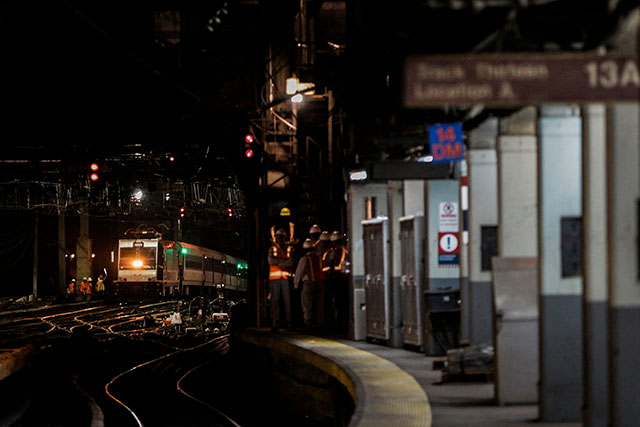
Track workers inspecting rails in tunnel coming into Pennsylvania Station where trains have repeatedly derailed.
(Photo: Jeenah Moon for The New York Times)
The transit malaise has been going on for at least a decade. Since 2007, on-time performance has decreased by more than half on every single line in the New York City transit system. It’s assumed that a train may be delayed or re-routed at any time, for any reason. Service changes are so labyrinthine that life-long subway riders are left scratching their heads in confusion. The MTA’s new marketing scheme, Fastrack, is supposed to convince commuters that they’ve got it all under control, with scheduled service cutbacks on the weekends that supposedly allow time for repairs. Reeling off the list of these service changes is like being read the dinner specials at a Midtown restaurant (F trains will run express on the A line, A trains go local on the F line, 2 and 5 trains will switch in Manhattan, take a shuttle bus from 168th St., etc.). Or hearing a drug’s possible side effects in a TV commercial (WARNING: Fastrack may increase risk of depression, homicidal and suicidal thoughts, and proclivity for violence).
When trains are stalled, passengers are treated to pre-recorded announcements blaming it on “train traffic ahead,” or “a police investigation underway” at another station. A New York Times column by Jim Dwyer skewered the so-called “earlier incident” announcements – a catch-all reason used to justify service cuts that riders are sick of hearing. Dwyer cites the MTA’s signal network as the second most common cause of delay (“Because of an Earlier Incident, This Column May Infuriate You,” New York Times, 22 June). The MTA’s new/old transit chief, Republican Joe Lhota (who was MTA chairman after Hurricane Sandy, now re-appointed by Cuomo) noted, “We live in a digital age. Our signal system isn’t even analog. It’s mechanical.” In addition, the frequency of signal inspections has been cut by two-thirds – from every 30 days to every 90 days. Result: more and more signal malfunctions. Inspections of MTA’s “new” fleet of decade-old train cars have also been cut back.
What’s evident to anyone who rides the subway is that the system is crumbling and in dire need of repair, maintenance and restoration. But the fact that the MTA bosses cut weekend service to less-than-bare minimum to carry this out is a reflection that New York’s “mass” transit system is not there to serve the mass of working people, but rather the needs of capital. So long as workers and corporate administrators get into Manhattan on time during the week, the bosses are at ease. It’s only when maintenance cuts into morning rush hour commutes that city rulers get up in arms – hence Cuomo dubbing the Penn Station repairs a “summer of hell.” The truth is, working people have been experiencing the hell of riding subway and regional rail for decades.
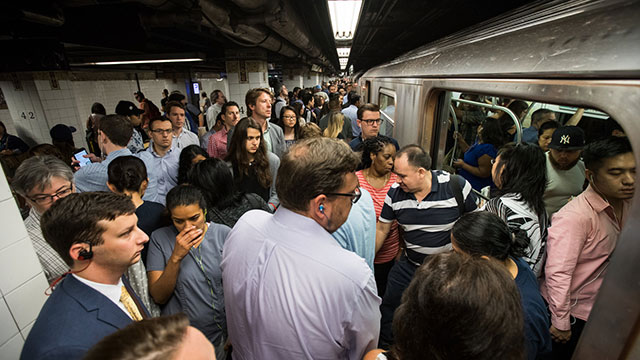
Grand Central Station at rush hour, July 2017. Since 1986 the number of passengers has increased by 80% to 1.8 billion annually, but the number of subway cars stayed the same while the number of transit workers has fallen.
(Photo: Benjamin Norman for The New York Times)
Dwyer and the bourgeois liberals who administer NYC for Wall Street see the main culprit as overcrowding. Since 1985, subway ridership has increased from 1 billion annually to 1.8 billion, an 80% growth in volume. Yet the number of subway cars in service and miles of track in the system have not increased at all, and the number of NYC transit workers has fallen by 8% (from 51,500 to 47,500). The liberals see a system bursting at the seams with new riders, crazed Republicans in Washington slashing Amtrak funding, a governor in control of the MTA who plays the blame-game with Mayor De Blasio, and no obvious way out, especially since the increased ridership reflects that New York’s economy is up compared to the rest of the U.S.
Liberal pundits also point to political corruption as the problem. But the whole system is based on political patronage. The MTA board are all political appointees and few have even a clue about transit. Historically, most appointees by the governor represent real estate interests in New York City and the surrounding area. In fact, Joe Lhota made a cool $13 million in 2013 from real estate investments, according to the New York Times. In return for handing over the MTA board to the wheeler-dealers of New York City’s local bourgeoisie, Cuomo receives millions in campaign contributions from those very interests. The MTA’s recently completed capital projects show how pervasive their control is.
The 7 line’s one-station extension to the former Hudson Rail Yards, now the largest private real-estate development project in the country (which Donald Trump’s company once headed up), cost $2.1 billion. The renovated PATH station at the World Trade Center, which did not extend a single foot of track or increase passenger capacity, cost $4 billion. The three-station extension of the Q line along Second Avenue cost $4.5 billion, and they made sure to stop short of Harlem. Even the big business media couldn’t miss the obvious racism of that. What do these capital projects have in common? They are of little use to subway riders but raise the value of real estate in their respective areas, bolstering profits begot through speculation.
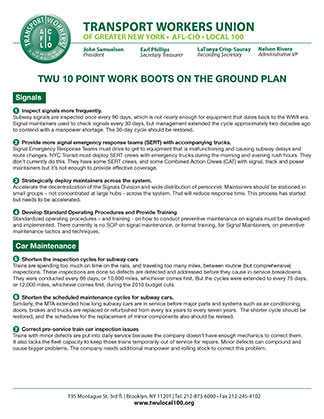 MTA action plan
ignores transit union’s top points calling for sharply
increased inspection of all signals and cars.
MTA action plan
ignores transit union’s top points calling for sharply
increased inspection of all signals and cars. With public outcry reaching a fever pitch, the bourgeois politicians and transit bosses have weighed in with their emergency fixit programs. MTA chief Lhota announced an NYC Subway Action Plan, a grab bag of measures, several of them recycled from the Authority’s earlier “six-point plan” announced last May. This includes stationing EMT teams, “combined action teams” and subway repair rapid response teams near key stations. The purpose of these steps is to cut down on delays, aiming at reducing average response time from 45 minutes to 15 minutes. Beyond such obvious steps, Lhota’s prime proposal was to remove seats to make “standing only” cars to jam in another two dozen passengers each! Another of the MTA boss’s bright ideas was to solve the problem of subway trash by banning eating on the trains!!
Now a detailed analysis by the Times (“New York’s Subways Are Not Just Delayed, Some Trains Don’t Run at All,” 8 August) shows that the policy of spacing out trains, even after delays have exacerbated severe overcrowding, has led to “dozens of trains being canceled every day and reducing the system’s capacity by tens of thousands of riders.” On the Lexington Avenue corridor (4, 5 and 6 trains), only 77 of 90 scheduled trains pass through Grand Central Station at the height of the morning rush hour (8 to 9 a.m.), and 76 out of 88 trains from 5 to 6 p.m. Rather than inserting more trains, which can run as frequently as 2-3 minutes apart, even with antiquated technology, in an interview “Mr. Lhota said the agency should adjust the published schedules to reflect current conditions”!
Meanwhile, the underlying problems of signal, track and power problems, which cause over half the delays and most of the derailments, get short shrift. The MTA action plan vows to fix 1,300 of the most problematic signals (one-tenth of the total) by some time next year. However, the plan does not address the No. 1 point in Transport Workers Union Local 100’s plan, to have signal maintainers check all signals once a month instead every 90 days. Nor does it shorten the inspection and scheduled maintenance cycles for subway cars, or provide for “gap trains” to fill in for delayed trains – as the TWU proposed and the MTA used to do. While the Agency says it will hire 2,700 workers, several times that many are needed to ensure adequate maintenance and sharply increase the frequency of trains to alleviate the excruciating overcrowding.
Rather than fixing the subways, the MTA boss is setting out to increase the pain and discomfort of the more than 6 million passengers a day who endure the dysfunctional mass transit system. Times columnist Dwyer noted that the MTA allots three square feet standing room per person, compared to five for a 150-pound sheep on a boat. The author of livestock handling guidelines for the American Meat Institute remarked that subway cars are more crowded than cattle or pig trucks. And if the MTA has problems enough with delays due to sick passengers, wait until they have pregnant women and elderly passengers collapsing with nowhere to sit in seatless trains.
Of course, it is not a matter of a particularly misanthropic (people-hating) administrator, but of the priorities of the capitalist class whose interests he represents.
NYC Subways and Capitalist Crisis
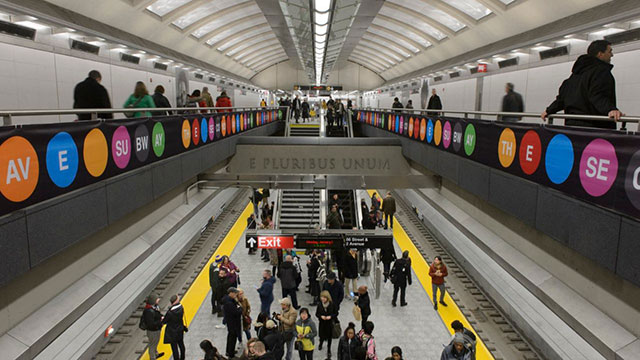
MTA is spending billions of dollars building palaces that serve to raise area real estate prices, like the Second Avenue subway above, but that do nothing to upgrade deteriorating subways. (Photo: Charles Eckert/amNY)
Throughout the 2016 presidential campaign, between his xenophobic, racist and sexist tirades, Donald Trump gesticulated about increasing infrastructure spending. His vision for infrastructure is profitable infrastructure, which means privatization. MTA chief Lhota has taken up this theme, calling for companies to “adopt a station” in exchange for naming rights, as with sports stadiums. But privatization could never make mass transit profitable – it would inevitably increase fares and cut services, which would decrease ridership and interfere with everyone’s ability to get to work. An ensuing labor shortage could cut into profits. Yet the very reason U.S. infrastructure is falling apart is because of the U.S. capitalist class’s falling rate of profit – which was underlined by so-called fiscal crisis of the 1970s.
After the Vietnam War, the Federal government was faced with the consequences of running a massive budget deficit to simultaneously finance the war and poverty programs aimed at heading off ghetto unrest. What took shape was a massive counter-offensive by the bourgeoisie against the working class, beginning with public-sector unions. In NYC, this meant attacking the sanitation workers, teachers, and transport workers. In 1975, the Municipal Assistance Corporation (“Big MAC”), headed by Lazard Frères investment banker Felix Rohatyn, was set up by the state to lead the assault. MAC was invested with the authority to issue special New York City bonds to attract investment, after Wall Street declared the city insolvent.
To restore profitability, the ruling class sought to reduce expenditures on “social overhead capital” by slashing taxes and cutting spending on transportation, education and other vital public services. MAC imposed a 10 percent wage cut on city unions, fare hikes for subways, an end to open admissions at the City University (CUNY) and the introduction of tuition. In addition, the state set up an Emergency Financial Control Board (EFCB) with direct control over the city’s finances. The EFCB “deferred” (stopped) all infrastructure maintenance – including bridges, tunnels and subways. Today, the sorry state of mass transit in NYC can be directly traced back to 1975, Big MAC, the EFCB, Democratic governor Hugh Carey, Democratic mayor Abraham Beame, and the financial moguls they served.
The capitalist assault on NYC, which left the MTA $34 billion in debt to the very banks who forced NYC into bankruptcy, was then generalized nationally and internationally with closures of auto plants (particularly those with the most militant workers), union busting (PATCO, Hormel, Greyhound), defunding of public schools and a stepped-up ant-Soviet Cold War, from Afghanistan to Central America. The deliberate dilapidation of New York City’s subways was not about “fiscal irresponsibility,” “spendthrift” city governments and the like, but the first act of a broader war on the unions and the Soviet Union, the first workers state in history. Following the counterrevolutionary destruction of the (bureaucratically degenerated and deformed) workers states of the USSR and East Europe, the global capitalist war on working people escalated.
The deterioration of the New York City subways is not an isolated phenomenon, but reflects the overall course of world capitalism. To bolster sagging profits, the bosses slash labor costs by speed-up, lowering wages by union-busting, outsourcing production to low-wage countries and other means. They short-sightedly defer maintenance on constant capital and key infrastructure. They “invest” in speculative “bubbles” (the tech bubble, dot-com bubble, housing bubble). And when the whole financial edifice comes tumbling down, as it did in the market crash of 2007-08, the capitalist government “bails out” the Wall Street financiers while imposing “austerity” and mass unemployment on the workers, throwing millions out of their jobs.
This is not going to change by adopting a different economic policy, for example by junking “neoliberalism” and returning to Keynesian deficit financing, as many liberals and reformists wish. The capitalist system as a whole is in economic crisis. Sure, it’s quite possible to solve the crisis of the NYC mass transit system in relatively short order. The MTA could hire thousands of new operators, conductors, engineers and maintenance personnel to increase the frequency of trains. They could double the trains on lines open on weekends and intensify modernization work on others. They could greatly accelerate the introduction of communications-based-train-control (CBTC), and adopt stop-gap systems to reduce congestion on key lines (Lexington and Eighth Avenue corridors). But they won’t because the substantial cost won’t produce immediate profits.
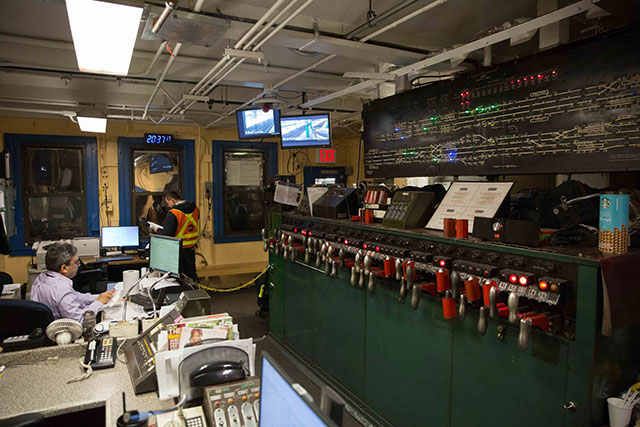
Above: West 4th Street Tower controls much of subway train traffic in Lower Manhattan with 1930s equipment. Below: some of the pre-WWII signaling technology still in use. (Photo: Kevin Hagen for the New York Times)
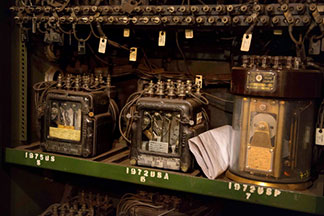
The problems of the New York City have been exhaustively analyzed, and the solutions are known. The signals at key centers (such as the W. 4th Street Tower in Manhattan) date back to the 1930s, involving hand-turning of switches and wires encased in cloth, which could lead to total chaos in case of even a small fire. A decision to go over to CBTC was made after a deadly 1991 accident at the 14th Street station on the Lex that killed five people. But at the present pace, introducing modern computer controls on every subway line would cost $20 billion and take half a century. Twenty-five years on, they have only been introduced on the L line, where they didn’t buy enough CBTC-equipped cars and there were still long wait times between trains. And that line is where Lhota proposes to start ripping out seats!
Capitalist imperatives govern every aspect of the public transit system. Three years ago, the Regional Plan Association published an extensive report (Moving Ahead [May 2014]) on accelerating the transition from “fixed block” to “moving block” (CBTC) signal systems. But since these planners are governed by the criteria of the profit system, they want to link such technology that increases safety and efficiency to replacing two-person train operating systems (driver and conductor) with one-person (OPTO) or driverless trains. This is a recipe for a deadly disaster. Imagine what the casualties from the June 27 derailment of the A train at 125th Street would have been if there had been no transit workers to guide passengers through the smoke-filled tunnel. Luckily, in the past TWU Local 100 has resisted such moves.
A Class-Struggle Program for NYC Transit
Independent union action is key to a safe, efficient and comfortable mass transit system, for it can go against the demands of capital. A militant union leadership would fight to revive and implement the TWU’s historic demand for free mass transit. NYC mayor de Blasio now wants to introduce half-price fares for low-income New Yorkers. But this would only benefit those below federal poverty levels ($12,000 annual individual income, $16,000 for a couple), making the vast majority of workers pay the extortionate full fare that amounts to subway robbery. Instead of soaking the 6 million daily riders to the tune of $7 billion a year, unions and riders groups should call to abolish the fare and rip out the turnstiles. This would also put an end to the over 90,000 arrests and tickets yearly for the non-crime of evading the MTA’s rip-off fare.
A class-struggle leadership of labor would fight to refuse to pay the MTA’s staggering $40 billion debt burden imposed on it by Wall Street. In 1981 the Transit Authority had zero debt, but as the capitalists demanded tax cuts and bankers sought to cash in on bonds, the MTA’s annual debt service now totals over $3 billion, one fifth of its $15 billion operating budget. This includes continuing to pay interest and principal of bonds for infrastructure that has surpassed its useful life. And with all the financial flim-flam and funny-money bookkeeping by the Agency, a union fighting for the interests of transit workers and working people generally would demand to open the MTA’s books to inspection by union committees.
For mass transit to serve the interests of the working class rather than capital will require taking the subway and bus system out of the hands of the MTA bosses, the capitalist politicians and their masters on Wall Street and impose workers control. A first step in that direction would be to form union safety committees with the power to shut down the system in case of unsafe conditions on the tracks, for workers and passengers. Such committees would demand the installation of existing track safety technology that can put an end to the needless deaths of transit workers and a dangerous system in which an average of five workers a day suffer serious injuries (see “NYC Transit Workers: Fight for Track Safety and Free Mass Transit!” The Internationalist No. 46, January-February 2017).
To win any significant gains requires using the union’s tremendous power, residing in transit workers’ ability to bring the center of world finance capital to a grinding halt, just as they keep it moving round-the-clock year-round. That means defying New York’s union-busting Taylor Law which declares it illegal for public employees to strike. In 2005, TWU Local 100 struck in the face of massive fines on the union and individual members. But TWU leaders in Washington ordered the members back to work. On Day 3, despite the solid walkout and public support, Local 100’s then-president Roger Toussaint (who never wanted the strike, forced on him by a militant membership), collapsed and called it off. This capitulation resulted in a contract defeat, jail time for Toussaint, a $2.5 million fine on the Local, and each member docked five days pay.
The 2005 strike could have won, if it had a leadership up to the task. It underscored the need to oust the pro-capitalist union misleaders who have hamstrung workers’ struggles (Toussaint was constantly hobnobbing with Hillary Clinton, the Democratic senator from Wall Street) and to forge a leadership with the program and determination to wage the class struggle through to victory. Such a leadership would mobilize union power to stop racist police terror against African Americans, Latinos and immigrants, and to block I.C.E. raids and deportations. It would also demand all police (including armed MTA revenue agents) out of the unions.
It all comes down to a question of class power, and a political fight against the parties and politicians of capital. But Local 100 president John Samuelsen is in bed with Democratic governor Cuomo and the MTA. Last year, the governor put Samuelsen on the MTA board, no doubt a payoff for going two years without a contract. Now the TWU chief has lined the union up with Democrat Cuomo and Republican Lhota against liberal Democrat de Blasio. A big-dollar union TV ad campaign portrays the mayor as sitting on piles of cash for refusing to pony up half a billion dollars for the MTA, controlled by Cuomo, who has siphoned similar amounts from the MTA budget. Which bourgeois politician comes up with the dough is not the concern of workers and riders. A fighting TWU leadership would call to break with all the bosses’ parties and build a class-struggle workers party, as Painters Local 10 in Portland, Oregon did last year.
Bottom line: The 42,000-member Transport Workers Union Local 100 touches the lives of millions of New Yorkers in a way no other labor organization does but for the 150,000-strong United Federation of Teachers. Despite the best efforts of big business press to demonize transit workers (calling strikers in 2005 “rats”), masses of working people can see that if the TWU wins, we all win. To successfully fight back, labor must be at the forefront of all struggles of the oppressed, armed with a revolutionary program and a class-struggle leadership at the helm fighting for a workers government. ■
Defend Darryl Goodwin!
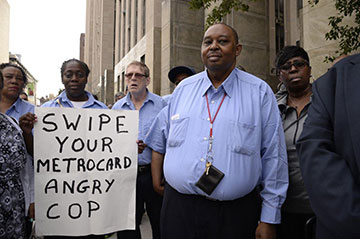 Darryl Goodwin together with
TWU Local 100 supporters outside court, June 29.
Darryl Goodwin together with
TWU Local 100 supporters outside court, June 29. (Jefferson Siegel/New York Daily News)
Class-struggle unionism also means defending workers to the hilt against victimization. Last May 17, station agent Darryl Goodwin, a black 27-year transit worker and member of Local 100, was arrested and suspended from his job without pay for not stopping assisting a passenger and not immediately opening a gate for a posse of cops (who have keys and duty Metrocards) chasing a suspect. He did so as soon as the police identified themselves. For that he was hit with frame-up charges of obstructing government administration, resisting arrest and causing injury to a police officer. All workers should defend Darryl Goodwin and demand that all charges be dropped and his lost wages be paid. At a court hearing on June 29, dozens of transit workers showed up to support their union brother. A new hearing is scheduled for Thursday, August 10 at 100 Centre Street in Manhattan. Unionists and opponents of racist cop terror should be there to pack the courtroom. ■